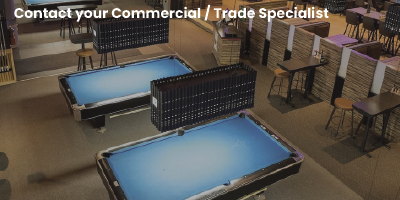Billiard Table Purchase Frequently Asked Questions
John Roufas2022-02-13T09:36:45-04:00BILLIARD TABLE PURCHASE FREQUENTLY ASKED QUESTIONS
Canada Billiards and Herrington both encourage their dealers to use the website as an informational tool for their tables. If a dealer wants to display the price they should use the Manufacturer Suggested Retail Price (MSRP). We have decided not to show this price since our retail prices are much lower then the suggested retail price. If you would like to know what our store sells a particular table package for please contact customerservice@fgbradleys.com or visit one of our showrooms.
Don’t worry…we’ve got you covered. All our billiard tables come with a lifetime manufacturer’s warranty. We’re confident you won’t need it, but it’s our commitment that your purchase will be worry free.
Tables are classified by what types of rails they have and the subsequent pocket openings, which dictate the size of balls used. Snooker can still be played on a pool table and pool can be played on a snooker table, as long as the correct ball size is used in accordance with the table being played on.
The rails on a snooker table use an “L” shaped rubber giving a flat point of contact for the balls. The rubber is also rounded at the pocket opening, resulting in a smaller opening. An official size snooker table is 6 feet by 12 feet, with a playing surface of 70 inches by 140 inches and you play with a 2 1/16 inch diameter ball.
Pool tables have a “V” shaped cushion rubber and the pockets have a square opening. These rails require a 2 ¼ inch diameter ball. Official size pool tables are 4 ½ feet by 9 feet (50 inch by 100 inch playing surface). The most common size table for a home is a 4 foot by 8 foot table.
Snooker Table | Pool Table | |
| Maximum Size: | 6′ x 12′ | 4½’x9′ |
| Playing Surface: | 70” x 140” | 50” x 100” |
| Cushions: | L-shaped rubber | V-nose rubber |
| Ball Size: | 2 1/16″ | 2 ¼” |
| Pockets: | 3″ – 3¼” | 4 7/8″ – 5 1/8″ |
The base of the shade should be between 32 and 34 inches from the table’s playing surface. As a table’s playing surface is between 29 ½ and 30 ½ inches above the floor, the base of the shade should be between 61 ½ inches and 64 ½ inches from the floor.
A three shade or, if one piece, 42” lamp is sufficient for 3 ½ foot by 7 foot and 4 foot by 8 foot tables, and adequate for 4 ½ foot by 9 foot tables. A four shade is ideal for a 4 ½ foot by 9 foot table, but barely adequate for a 5 foot by 10 foot table.
Larger snooker tables such as 5 foot by 10 foot and 6 foot by 12 foot tables are recommended to have five shade lamps.
A 60 watt globe bulb is ideal for lighting a billiard table.
Measure the playing area from the nose of the cushion rubber to the opposite cushion rubber, both width and length. A regulation table has the following dimensions:
Table Size | Playing Surface Size |
4 x 8 Table | Playing area 44″ width by 88″ length |
4 1/2 x 9 Table | Playing area 50″ width by 100″ length |
5 x 10 Table | Playing area 56″ width by 112″ length |
6 x 12 Table | Playing area 70″ width by 140″ length |
BCA will sanction Tournament Play on home and coin-operated tables produced in sizes other than those recognized above, if the playing area width is one-half the length, measure cushion to opposite cushion.
The table bed height when measured from the bottom of the table leg will be 29 ¼” minimum to 31″ maximum.
All playing surfaces must be secured to base frame with screws and bolts.
All Canada Billiard and Herrington tables follow the BCA specifications.
The amount of space needed for a table depends on what size of table you are looking for and what type of obstructions you are dealing with. Typically a distance of about 4 ½ feet around the table will give you full clearance. That will allow a shot perpendicular to the table with the cue ball touching the rail. You can certainly get away with less space than this. Most shots are made on an angle and the cue ball is usually away from the rail. If you are a little short, not to worry, cue lengths come as short as 36 inches. To find out exactly what space you need and what cue lengths are required, please see Plan your Game Room.
Originally, almost all billiard slate came from Italy. Since slate is not a renewable source, over the last 100 years the price of Italian slate has steadily increased. To keep the price of billiard tables reasonable, investments were made to discover alternative sources. Slate is found in many places around the world, has many different properties and even comes in different colours. While Italian slate is mined underground and has a grayish black coloring, Brazilian slate is mined in open pits and has a greenish hue. Brazilian slate is harder than Italian slate and hence less flexible. This makes it much more difficult to process the Brazilian slate, but, alternatively, it is much easier to store and transport. The playability of both types of slate is essentially equal. The most important characteristic of slate is its flat surface. This is a direct result of the machining process and has nothing to do with the slates country of origin or colour.
A thicker slate has better playability. Being heavier, 1 inch thick slate will vibrate less than ¾ inch. A moving ball will retain more of its energy, resulting in faster play. Less vibration in the slate will also give a truer or straighter shot, as well as quieting the sound of balls rolling on the table.
Billiard balls, both pool and snooker sizes, can be made from two materials: polyester or phenolic resin. Although more expensive, phenolic resin balls are well worth the investment, lasting up to five times longer than polyester. The number one producer in the world of phenolic resin balls is a company called Aramith, based in Belgium. The balls they produce will not only last longer, but will also play better. They are chip and scratch resistant, which will not only increase the lifespan of the balls, but it will also protect your cloth as well. Nothing chews up billiard cloth like chips and scratches in a billiard ball, and once one ball gets a chip, they all start chipping. Phenolic resin balls also are resistant to heat caused by friction.



